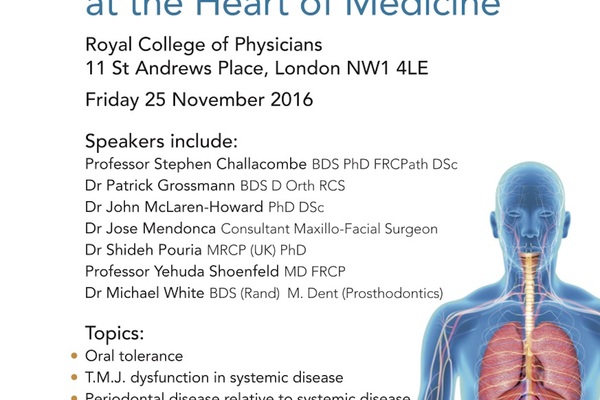Review by Dr Shideh Pouria:
BSEM Conference November 2016
Putting Oral Health at the Heart of Medicine
The joint annual conference of the British Society for Ecological Medicine (BSEM) with the Allergy Research Foundation (ARF) took place on Friday 25th November at the Royal College of Physicians in London. The topic for 2016 was “Putting Oral Health at the Heart of Medicine”. The conference organising committee had met earlier with BSSCMD members Drs Patrick Grossmann,Michael White, and Noel Stimson to create a programme that integrated the dental, medical and surgical disciplines into one.
The day started with brief introductions from Drs Shideh Pouria, Goran Stojanovic, and Belinda Samari setting the scene from the medical, dental, and historic perspectives. This was followed by a talk by Professor Stephen Challacombe from the London Dental Institute at GKT in which he discussed “the Translation of Oral Tolerance from Models to Clinical Practice”. He gave a highly detailed overview of oral immune mechanisms and responses, explaining why the oral cavity is a key part of the body’s overall mucosal immune system, and that for the same reason, “oral tolerance may provide a novel strategy for the treatment of many inflammatory disorders”. This suggests that the mouth could be an ideal site for the rapid delivery of desensitising vaccines in such a manner as to reduce the likelihood of producing any unwanted immune responses. The science he presented fitted in with the experience of clinical ecologists using oral desensitisation and low dose immunotherapy.
Michael White spoke next about dental neurology, oral structure and good dentistry. He stressed the importance of achieving a good arch-form or a Roman arch as opposed to a narrow triangular arch for dental stability, good airway function and general health. The importance of healthy TM joints was also crucial to achieving this. Both these goals form the basis of good dentistry.
Patrick Grossmann, later in the morning session gave an impassioned presentation on “the Temporomandibular Joint – the Great Imposter”, outlining how the multiplicity of TMD symptoms can present resembling many other (medical) conditions. His main concern, though, was that dentists and orthodontists must establish a new patient’s TMJ status before commencing any treatment, reversible or otherwise. The worst thing a dentist could do, he believes, was to treat the teeth when the joint or joints were ‘off the disc’, thereby committing the patient to a possible lifetime of symptoms. Working as a team with other healthcare professionals was the only way to be certain these goals were achieved.
Dr Shideh Pouria described an “Integrated Approach to Rheumatic Disease – Getting to the Root of the Problem” in which she presented four cases of rheumatoid arthritis who had responded dramatically well to a joint medical and surgical approach dealing with numerous instances of dental toxicity due to amalgam fillings, metal bonded and gold crowns, and root-filled or necrotic teeth. The improvement in rheumatic disease in these cases was truly remarkable once the sources of the toxicity had been addressed. The relationship between focal infections and autoimmunity was explored through cases with infected dental roots that were treated with anti-microbials and surgery. The response was remarkable in all 4 cases. One of the patients, a Malaysian doctor, was actually present at the conference and delighted the delegates by telling the story of her own recovery.
Noel Stimson, starting the afternoon session, offered an overview of the ecological and environmental issues that affect dentistry and link it with medicine. He started by outlining the different environments of birth, the cranium, the mouth itself and the politics (with a small ‘p’) that affect healthcare and dentistry. He included the work of the BSSCMD and drew parallels between that group and the BSEM.
Dr John McLaren-Howard, of Acumen Labs, described how the mouth presents a challenge; as an environment it is wet, warm, full of bacteria, all serviced by acidic saliva - ‘the universal solvent’. Add chewing and electrical activity from differing metals into the mix, and we have a hugely challenging situation when faced with a toxic oral cavity. This is made worse by the fact that many dentists do not actually know or understand the chemical components of the various restorations (fillings, root fillings, implants) they are placing in their patients’ mouths. In particular, great care should be taken when exposing a patient for the second time to a previously used sensitising metals or chemicals. Hence the importance of knowing the chemical composition of one’s dental materials and looking at sensitivity reactions as well as toxicity.
Dr Jose Medonca Caridad spoke about the holistic approach to oral pathology and dentistry using biological techniques. He presented the state of the art methods in biological surgery using autologous stem cells and protein rich plasma in reconstructing facial bones. He also discussed the use of more biocompatible materials in dentistry and oral surgery such as zirconia.
Dr Ilay Maden spoke separately about the holistic uses of surgical laser in oral pathology and dentistry which has the potential for reducing the necessity for the more invasive techniques currently available.
Dr Francesco D’Aiuto from the Eastman Dental Hospital spoke about the systemic implications of periodontal disease and its relationship to pretty much most degenerative disease such as metabolic syndrome, autoimmunity and neurodegenerative diseases.
The entire conference was full of interest and good information, repeatedly linking oral conditions with systemic medical conditions, probably all at a much deeper and more significant level than previously understood by many delegates, medical and dental. To purchase a recording of the full conference and its handout or any of the other previous BSEM events

